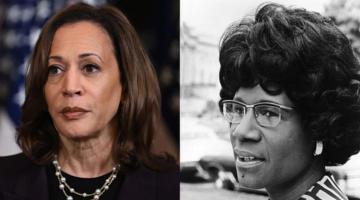The Democratic Party dug its own grave decades ago when it began trying to siphon voters from the GOP by appealing to conservatives and ignoring the needs of its strong base of African American people.
Originally published in Jon Jeter.
If political parties were prominent people, you might’ve stumbled upon this obituary today:
The Democratic Party, one-half of America’s longstanding ruling duopoly, and the author of political movements as disparate as Jim Crow and the New Deal, died Wednesday, July 24. It was 196.
Sources said the cause was suicide following a long illness.
While the chorus of television pundits attribute Joe Biden’s withdrawal from the presidential campaign to his abysmal performance in last month’s debate, his announcement yesterday that he has decided to pass the torch to his Vice-President Kamala Harris is the result of the party’s own internal polling that consistently shows him losing to the Republican nominee, Donald Trump.
It is important, however, to view Biden as a vital organ in a larger body politic that finally flatlined after failing to address a chronic disease, akin, say, to a diabetic eating Big Macs every day for the past 30 years. Biden does not, in fact, owe his failed reelection bid to senility—though his cognitive decline is apparent--but to his party’s strategic decision three decades ago to compete with Ronald Reagan’s GOP for racist, white suburban voters by openly repudiating the Democrats’ electoral base of African Americans.
Transferring the nomination to Harris is, in fact, a tacit acknowledgment of the open grave that the Democrats have dug for themselves. The hope, clearly, is that Harris, who has a Black father, can, like Obama 16 years ago, lure African Americans to the polls while also keeping white liberals in the fold. But Harris is deeply unpopular with Black voters, and her nomination is tantamount to propping up a corpse as in the 1989 cult classic movie, Weekend at Bernie’s.
How did the Democratic Party arrive at this historical moment?
Let’s review:
If the Republican Party was known as the party of Abraham Lincoln in its formative years, the Democratic Party, was, from the moment of its inception in 1828, the spitting image of Andrew Jackson, reflecting the political values of a barbaric, landowning settler elite that sought to accumulate enormous wealth through chattel slavery and the ethnic cleansing of Native Americans.
Jackson signed the “Indian Removal Act” into law in 1830, and he and his Democratic successor, President, Martin Van Buren, terrorized the indigenous population, driving 70,000 Native Americans from their ancestral homes east of the Mississippi River. In 1845, President James Polk, another Democrat, declared war on Mexico to annex territory from Texas to California, leading a journalist identified with the party to proclaim that same year that it was the United States’ “manifest destiny to overspread the continent…”
The Civil War derailed the party, however, rooting Democrats from their Southern strongholds until 1877 when Republican President Rutherford B. Hayes began to withdraw federal troops from the vanquished Confederacy as part of a compromise with his political rivals. That effectively inseminated a century of Jim Crow; with no one to police them, lynch mobs organized by the Democrats had free reign to bully African American men who voted in near-unanimity for the GOP.
Simultaneously, the Democrats pioneered the use of racial storytelling to speak something called a “n!&&er” into existence.
That strategy climaxed in 1898 when three Democratic operatives—Furnifold Simmons, Brantley Aycock and Josephus Daniels, publisher of the Raleigh News and Observer—organized the first coup d’etat in U.S. history. Unable to defeat a progressive coalition of white Populists and Black Republicans at the ballot box, Simmons, Daniels and Aycock devised a public relations campaign intended to portray Black men as serial rapists of white women, thereby sparking a racial massacre in Wilmington, North Carolina. The plan worked: days before election day, a white mob murdered hundreds of African Americans and forced hundreds more forced to flee. Democrats would go on to rule the South for the next 70 years.
In the interim, however, the Democrats reinvented the party, beginning in earnest with the election of one of their own, Franklin Delano Roosevelt, to the White House at the nadir of the Great Depression. In his effort to save capitalism from eating itself, Roosevelt’s policies cut workers—both Black and white-- in on a new deal, raising wages, modernizing the state, and creating what remains, to this day, the singular miracle of the Industrial Age: The American middle class.
To be sure, Democrats, especially in the South, continued to hold African Americans at arm’s length, but as a practical matter, could not altogether exclude Black workers from a coordinated effort to imbue the economy with the consumer buying power it needed to function. African Americans began to desert the GOP in droves and within a generation, had become the Democrats’ most ardent supporters. Beginning with Roosevelt’s inauguration in 1933, a Democrat would occupy the White House for 28 of the next 36 years.
The liberal consensus began to dissipate, however, following the 1968 assassinations of Martin Luther King, Jr. and Robert F. Kennedy; protests against the escalation of the war in Vietnam; the emergence of polarizing movements such as the Weather Underground and Black Panthers; and, perhaps most importantly, the maturation of postwar industries in Western Europe and Japan, which began to eat away at the profit margins of domestic industries, increasing competition for good-paying, unionized jobs on the factory floor.
In an effort to divide the already-tenuous New Deal coalition, President Richard Nixon’s Southern strategy manipulated affirmative action and other race-specific policies to exploit racial tensions, Jimmy Carter ignored them, and Reagan detonated them.
By 1992, Democrats had not won the White House in 16 years. Plotting their comeback strategy they reverted to their old ways, choosing Reagan’s racial wedge politics over Jesse Jackson’s 1984 and 1988 presidential campaigns which achieved some measure of success in reuniting the New Deal’s loose federation of Black and white workers.
This strategy became painfully obvious in 1992, just days before Super Tuesday’s primaries, when William Jefferson Clinton’s appeared at a press conference outside the Stone Mountain Correctional Institution in suburban Atlanta. Appearing alongside Georgia Governor Zell Miller, U.S. Senator Sam Nunn, and Congressman Ben Jones—who played “Cooter” on the Dukes of Hazzard—Clinton would say later that his only motivation was to shine a light on an innovative prison reform project that had reduced recidivism. But the writer Nathan Robinson would describe the event as “a press conference of little apparent purpose except to show [white politicians] standing in front of a phalanx of dour, jump-suited inmates, all but a sprinkling of whom were Black.”
Responding to newspaper photographs of the media event, Clinton’s rivals for the Democratic party’s nomination were quick to denounce the Arkansas governor. California Governor Jerry Brown compared Clinton and his mates to “colonial masters” soothing white settler fears of a rumored slave revolt or an attack by a Native American tribe. “Don’t worry, we’ll keep them in their place. ... Two white men and forty Black prisoners, what’s he saying? He’s saying we got ’em under control, folks.”
Often described by newspaper columnists as a man of both great intellect and rapacious appetites, the Ivy League-educated Clinton’s real genius was reheating old ideas and repackaging them as his own. His Stone Mountain photo op almost certainly was intended to ape Reagan’s campaign debut 12 years earlier in Mississippi’s Neshoba County, where three civil rights workers were slain by the Klan in 1964.
All the more revealing was that Clinton’s electoral strategy did not reach out to disaffected African Americans in any substantive way—other than playing the tenor saxophone (badly) on Arsenio Hall’s late-night talk show-- but instead focused on white suburban Democrats who were attracted to Reagan’s sectarianism.
No jurisdiction in the country represented that electoral bloc known as “Reagan Democrats” better than the Detroit suburb of Macomb County. According to a 1992 Washington Post profile written by Thomas Edsall, Macomb is:
"a working-class county that in 1960 won attention as the suburban area casting the nation's highest margin of votes for Democrat John F. Kennedy. Since then, the overwhelmingly white electorate has moved steadily toward the GOP, with much of the momentum driven by racial issues: the Detroit riots of 1967, a 1974 federal court order for intercounty busing with Detroit that was overruled by the Supreme Court, constant battles over tax dollars with predominantly black Detroit. In combination with the accelerating decline of the auto industry during the Democratic administration of Jimmy Carter, these forces produced a rebellion against the Democratic Party and 2-1 ratios for Republican presidential candidates. In the mid-1980s, this insurgency briefly threatened Democratic control of local offices, and desperate party leaders brought in pollster Stanley Greenberg, who in 1985 did not have good news. In a study of defectors, he found: ‘These white Democratic defectors express a profound distaste for blacks, a sentiment that pervades almost everything they think about government and politics. ... Blacks constitute the explanation for their vulnerability and for almost everything else that has gone wrong in their lives; not being black is what constitutes being middle class; not living with blacks is what makes a place a decent place to live.’ "
Wrote Louis Proyect in summing up research by the labor historian David Roediger:
"Eventually, Greenberg’s study became part of the core philosophy of the Democratic Leadership Council (DLC) that served as the premier think tank for politicians like Bill Clinton, Joe Lieberman, Bruce Babbitt, and Dick Gephardt. It was also home to campaign managers like James Carville, who eventually founded a consulting company with Stanley Greenberg that groomed politicians in the centrist politics that has dominated the Democratic Party to this day."
It is deliciously ironic then that the Democrats’ chickens will most likely come home to roost in, of all places, Detroit. Black turnout in the Motor City typically decides whether Michigan is Team Red or Team Blue and it is hard to imagine either Detroit’s dispossessed Black majority—or the city’s large suburban Arab population that pioneered the pro-Palestinian “uncommitted” vote in this year’s primaries—turning out in big numbers to vote.
Moreover, the main architects of the Democrats’ outreach to racists, Greenberg and Carville, were especially vocal in their appeals for Biden to drop out of the race. Reporters for CNN wrote that one Democrat described a polling memo that Biden sent to Greenberg as “Lose everything.” Another described Greenberg’s polling memos as “Devastating.”
Similarly, Carville wrote in a New York Times opinion article published two weeks before Biden announced his decision to drop out:
“Mr. Biden says he’s staying in the race, but it’s only a matter of time before Democratic pressure and public and private polling lead him to exit the race. The jig is up, and the sooner Mr. Biden and Democratic leaders accept this, the better. We need to move forward.”
It is worth noting that Biden has followed to a T Greenberg’s advice to the 1992 Clinton campaign to “keep demands for racial and gender justice meager.”
As a U.S. Senator, Biden authored the Clinton administration’s draconian 1994 omnibus crime bill, and nine years later pushed bankruptcy reform through the U.S. Senate, making it far more difficult for borrowers to avoid repaying onerous debts. Both measures disproportionately affected African Americans.
As president-elect, Biden sparred with a cadre of moderate civil rights leaders—including Al Sharpton and Sherrilyn Ifill, the then-executive director of the NAACP’s Legal Defense Fund—scolding the group for its demands to “defund the police” which Republicans had wielded like a hammer in the 2020 elections to “beat the living hell out of us.”
Later in the same call, NAACP President Derrick Johnson warned Biden that his nomination of Tom Vilsack to the cabinet position of agriculture secretary would anger African Americans, especially in Georgia, which Biden barely won. As Agriculture Secretary under Obama, Vilsack had fired a Black employee, Shirley Sherrod, from her position as Georgia’s director of rural development, after the release of a videotape which showed her making racist remarks against whites. The tape was later discovered to be a hoax.
In the conversation, Johnson told Biden:
If you consider the victory that you appreciated in Georgia, it was around 12,000 votes. And so as you consider appointments, you also must consider what impact would that have on voters in the state of Georgia. And I will submit to you that former Secretary Vilsack could have a disastrous impact on voters in Georgia. Shirley Sherrod is a civil rights legend, a hero.
Biden dismissed Johnson’s concerns out of hand.
In the media, African American pundits hail Harris’ promotion to the top of the ticket as Obama’s second coming. That is the problem: Obama was a one-off that was intended to gin up the Black vote at the very moment that the deeply racist sub-prime housing market was collapsing. In Obama’s eight years in office, Blacks lost more of their wealth than at any time since the collapse of the Freedmen’s Bank in 1874. You can argue that African Americans failed to hold Obama accountable, but it is unlikely that they will fall for the same bait and switch again, particularly with a politician whose relationship to communities of color is already strained.
As evidence of this, Black Lives Matter released a statement this week questioning the process by which Harris became the presumptive nominee ahead of next month’s Democratic National Convention.
"Democratic Party elites and billionaire donors are attempting to manipulate Black voters by anointing Kamala Harris and an unknown vice president as the new Democratic ticket without a primary vote by the public.
This blatant disregard for democratic principles is unacceptable. While the potential outcome of a Harris presidency may be historic, the process to achieve it must align with true democratic values."
In a 2016 New York Times article, a reporter interviewed African Americans at a barbershop in one of Milwaukee’s poorest neighborhoods following the election. Trump won Wisconsin despite winning fewer votes than the Republicans' 2012 nominee Mitt Romney, suggesting that it was not Trump’s popularity but Hilary Clinton’s unpopularity upon which the election turned.
Few of the Black men interviewed had voted for Clinton, and while they loathed Trump equally, did not express any regret about his election. One barber told the Times:
I don’t feel bad,” Mr. Fleming said, trimming a mustache. “Milwaukee is tired. Both of them were terrible. They never do anything for us anyway.”
Jon Jeter is a former foreign correspondent for the Washington Post, Jon Jeter is the author of Flat Broke in the Free Market: How Globalization Fleeced Working People and the co-author of A Day Late and a Dollar Short: Dark Days and Bright Nights in Obama's Postracial America. His work can be found on Patreon as well as Black Republic Media.



















